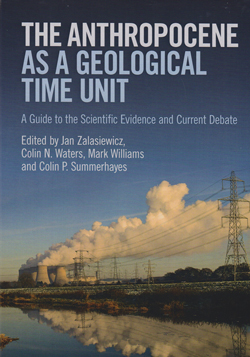
This is a book with a purpose, to inform the process of producing a formal proposal for the Anthropocene as a geological time unit. It is no easy read, but a detailed resource over the issues involved in the setting up of a geological unit that reflects our impact on the environment. Such a motivation is new in the context of the geological record, and it has been the subject of much debate across the natural and social sciences.
As a geological time unit, the Anthropocene would be a unit of Earth history, analogous to the Silurian, the Miocene or the Holocene, and not, for example, a diachronous unit of human cultural history, like the Iron Age or even the Renaissance. A key issue is how the beginning and end of such time units are best recognized, and fossils, and often mass extinctions, have been widely used. Should the onset of the Anthropocene therefore be based on the recognition of human impact, or on when sufficient change has taken place to warrant a new geological time unit? Ideally it needs to be global, and to be a time horizon, and it would be helpful to have a boundary that can be recognized in the field, and not just on the basis of some sophisticated laboratory measurement.
Most of the editors and authors are members of the Anthropocene Working Group, and the approach and the material discussed reflect their discussions and the journey this far. The book charts the history and development of the Anthropocene as a stratigraphic concept, and some of its stratigraphic signatures. The role of synthetic minerals and rocks, fly ash, plastics and refuse, mine wastes and the debris of war, metal pollution and changes in sedimentation rates, are discussed together with changes in chemostratigraphy in response to environmental and climate change, and those associated with species invasion and extinctions. Some appear more useful than others, but the discussion usefully highlights the nature of stratigraphic units in a contemporary context.
The figures are black and white, although some are then reproduced in colour plates in the centre of the book. Many are detailed, consistent with the tenor of the book, with the risk that they may be mostly studied by those who know what they are looking for. Nonetheless this is a welcome documentation of the details of the debate about whether the time is right to formulate a new geological time unit, what the term Anthropocene has meant to different communities, and how it might be best defined in materials that will survive in the geological record. It is a valuable resource for graduate students and researchers across scientific, social science and humanities disciplines, written by the group that has led the way to establish the Anthropocene as a stratigraphic geological time unit. Perhaps it should be on all our book shelves as we grapple with current and future environmental change.
Reviewed by Chris Hawkesworth
THE ANTHROPOCENE AS A GEOLOGICAL UNIT: A GUIDE TO THE SCIENTIFIC EVIDENCE AND CURRENT DEBATE, by Jan Zalasiewicz, Colin N. Waters, Mark Williams & Colin P. Summerhayes (eds) 2019. Published by: Cambridge University Press, 361 pp. (hbk)
List Price: £44.95
W: https://www.cambridge.org/